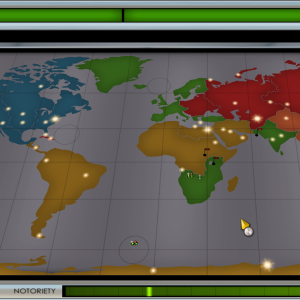 There’s a rich tradition in video games of villainous protagonists. One of the most interesting things about this trend is how it encourages you to understand and assign personhood to characters that you might otherwise demonize.
There’s a rich tradition in video games of villainous protagonists. One of the most interesting things about this trend is how it encourages you to understand and assign personhood to characters that you might otherwise demonize.
At Future Proof Games we’re motivated by a concept we call “audacious compassion:” exercising players’ everyday empathy skills by encouraging them to have compassion for characters that seem alien, evil, or irrational.
Villainous games align with this concept. Tie Fighter shows you how the underlings in a dictatorial government justify their actions as preserving order. Overlord depicts a character who does the right things for the wrong reasons. And Evil Genius depicts a supervillain who’s inordinately concerned with keeping people happy and entertained.
Lair Keeper
Evil Genius is a 2004 game1 heavily inspired by fellow villain game series Dungeon Keeper. You play a spy-movie scheming villain with an island base, carrying out evil plots in an eventual attempt to rule the world. You design the layout of your base, staff it with minions, and deal with secret agents trying to uncover your plans.
You have a number of secondary concerns in addition to carrying out your evil plots. You have to look after your minions’ needs, which you do with an assortment of whimsical base items. You have to prevent secret agents from learning too much or interfering with your plots, so you can build gauntlets of traps along with infrastructure for imprisoning, interrogating, and converting agents. And you also have to deal with tourists to your exotic item, whom you distract with exotic hotels and diversions.
Endless Distraction
Much of your task as an evil genius is occupied with keeping people from realizing you’re an evil genius. Your minions have a Loyalty stat, which drops when they see disheartening things like body bags. As a result, it’s wise to arrange for dead agents to be spirited away to freezers in secret, to maintain your minions’ illusions that maybe they’re not serving a really evil genius. Maybe just a misunderstood one.
Likewise, while secret agents can be killed and imprisoned, they can also be distracted and confused away. By setting up traps which sap their Attention and Smarts, you can cause them to forget what they’ve seen and become willing to be escorted out of your base. These traps can affect your own minions if they are overworked (i.e. if their own Attention is too low). It becomes a balancing act between security and efficiency.
The Sympathy of Toil
As a result, your evil genius is less a figure of diabolical chaos and more a hassled administrator with a macabre sort of whimsy. Far more of your time and effort is occupied with feng shui and personnel logistics than with actual villainy. Indeed, your actual Acts of Infamy are carried out off-screen; whether you’re clubbing seals or wiping Nashville off the map, you only really interact with the systems at your base.
While your evil genius’s motivations to arbitrary villainy are comical and incomprehensible, the difficulties of their day-to-day work life are totally sympathetic. The minions’ AI is smart enough to get simple tasks done, but stupid enough that you’ll feel the frustration of a megalomaniac who sees all of their underlings as incompetent. The much-deconstructed trope of tormenting agents rather than just killing them becomes completely sensible in the context of the game’s systems.
Evil Genius turns a comical archetype into someone you can relate to and sympathize with. By inhabiting the role of the evil genius, you understand and empathize with them, which may help you empathize with difficult people in your real life. Rather than seeing their end goals and declaring them irrational, you can take the lessons you learned in the game and consider their everyday problems and how that could lead them to behave the way they do.
This article was commissioned by a patron. To support my work, sign up for my Patreon and help me continue producing writing like this.
